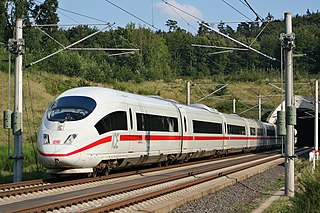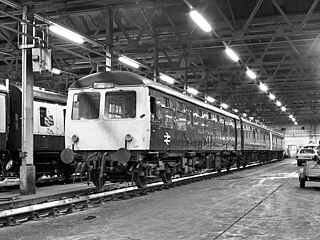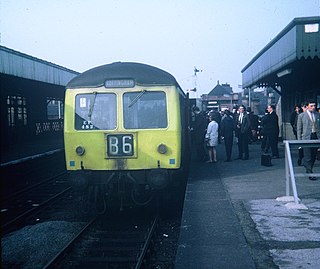
A diesel multiple unit or DMU is a multiple-unit train powered by on-board diesel engines. A DMU requires no separate locomotive, as the engines are incorporated into one or more of the carriages. Diesel-powered single-unit railcars are also generally classed as DMUs. Diesel-powered units may be further classified by their transmission type: diesel–mechanical DMMU, diesel–hydraulic DHMU, or diesel–electric DEMU.

A multiple-unit train is a self-propelled train composed of one or more carriages joined, which if coupled to another multiple unit can be controlled by a single driver, with multiple-unit train control.

A railcar is a self-propelled railway vehicle designed to transport passengers. The term "railcar" is usually used in reference to a train consisting of a single coach, with a driver's cab at one or both ends. Some railway companies, such as the Great Western, termed such vehicles "railmotors".

A diesel locomotive is a type of railway locomotive in which the power source is a diesel engine. Several types of diesel locomotives have been developed, differing mainly in the means by which mechanical power is conveyed to the driving wheels. The most common are diesel–electric locomotives and diesel–hydraulic.

The British Rail Class 73 is a British electro-diesel locomotive. This type is unusual in that it can operate on the Southern Region's 650 / 750 V DC third rail power supply, or an onboard diesel engine to allow it to be used on non-electrified routes. This makes it very versatile, although the diesel engine produces less power than is available from the third-rail power supply, so the locomotives are rarely used outside of the former Southern Region of British Rail. It is one of the first bi-mode locomotives ever built. Following the withdrawal and scrapping of the more powerful Class 74 bi-mode locomotives in 1977, the Class 73 was unique on the British railway network until the introduction of the Class 88 bi-mode locomotives in 2017. Ten locomotives have been scrapped.

The British Rail Class 127 diesel multiple units were built by BR Derby in 1959. Thirty 4-car units were built, formed of two outer driving motor vehicles, sandwiching two intermediate trailers which were classified class 186. The technical description of such as 4-car unit was DMBS + TSL + TS + DMBS.

The Endeavour Railcars are a class of diesel multiple units (DMU) operated by NSW TrainLink on passenger rail services in New South Wales, Australia on the Hunter, Blue Mountains, Southern Highlands and South Coast lines. They are mechanically identical to the Xplorers, but are fitted out for shorter travel distances. All 30 carriages were built by ABB's Dandenong rolling stock factory.
B-B and Bo-Bo are the Association of American Railroads (AAR) and British classifications of wheel arrangement for railway locomotives with four axles in two individual bogies. They are equivalent to the B′B′ and Bo′Bo′ classifications in the UIC system. The arrangement of two, two-axled, bogies is a common wheel arrangement for modern electric and diesel locomotives.
This article contains a list of jargon used to varying degrees by railway enthusiasts, trainspotters, and railway employees in the United Kingdom, including nicknames for various locomotives and multiple units. Although not exhaustive, many of the entries in this list appear from time to time in specialist, rail-related publications. There may be significant regional variation in usage.

The British Rail Classes 105 and 106 diesel multiple units were built by Cravens Ltd. of Sheffield from 1956 to 1959. The class were built with a side profile identical to British Railways Mark 1 carriage stock, using the same doors and windows. None were selected for refurbishment. The last passenger car was withdrawn from service in 1988.

The British Rail Class 107 diesel multiple units were built by the Derby Works of British Railways and were introduced in 1960. The class looked similar to the later Class 108 units, but were heavier, being built from steel.

The British Rail Class 126 diesel multiple unit was built by BR Swindon Works in 1959/60 to work services from Glasgow to Ayrshire and comprised 22 3-car sets and were a development of the earlier Swindon-built trainsets that had been introduced in 1955 to work the Edinburgh Waverley - Glasgow Queen St services. These vehicles formed the first Inter City service to be operated by diesel units in Great Britain.

The Class 112 and Class 113 DMUs used the standard Cravens body used on Class 105s but had a single Rolls-Royce C8NFLH engine rated at 238 hp (177 kW) per car, all of which formed into 'power twins' – two car sets with both vehicles powered.

The British Rail Class 115 diesel multiple units were 41 high-density sets which operated the outer-suburban services from Marylebone usually to destinations such as High Wycombe, Aylesbury and Banbury which are on the Chiltern Main Line and Great Central Main Line. Sometimes, these sets used to operate 8- or 12-car-long expresses to Nottingham Victoria in the final years of the GCML. Coincidentally, Class 115 units operated services under Table 115 in the British Rail timetable.

The British RailClass 141 is the first production model of the Pacer diesel multiple unit (DMU) railbus.

The British Rail Class 124 diesel multiple units were built by BR Swindon Works in 1960.

The DB Class 218 are a class of 4-axle, diesel-hydraulic locomotives acquired by the Deutsche Bundesbahn for use on main and secondary lines for both passenger and freight trains.
The Rolls-RoyceC range was a series of in-line 4, 6 and 8 cylinder diesel engines used in small locomotives, railcars, construction vehicles, and marine and similar applications. They were manufactured by the Rolls-Royce Oil Engine Division headed by William Arthur Robotham to 1963, initially at Derby and later at Shrewsbury, from the 1950s through to 1970s.
The Paxman Hi-Dyne engine was a form of experimental diesel engine developed for rail transport use by the British engine makers Paxman of Colchester. They used variable supercharging to give a constant power output across their speed range.

Diesel multiple units and railcars are trains, usually with passenger accommodation, that do not require a locomotive. Railcars can be single cars, while in multiple units cars are marshalled together with a driving position either end. As of December 2010, 23 percent of the rail passenger cars used on Network Rail are part of a diesel multiple unit.


















